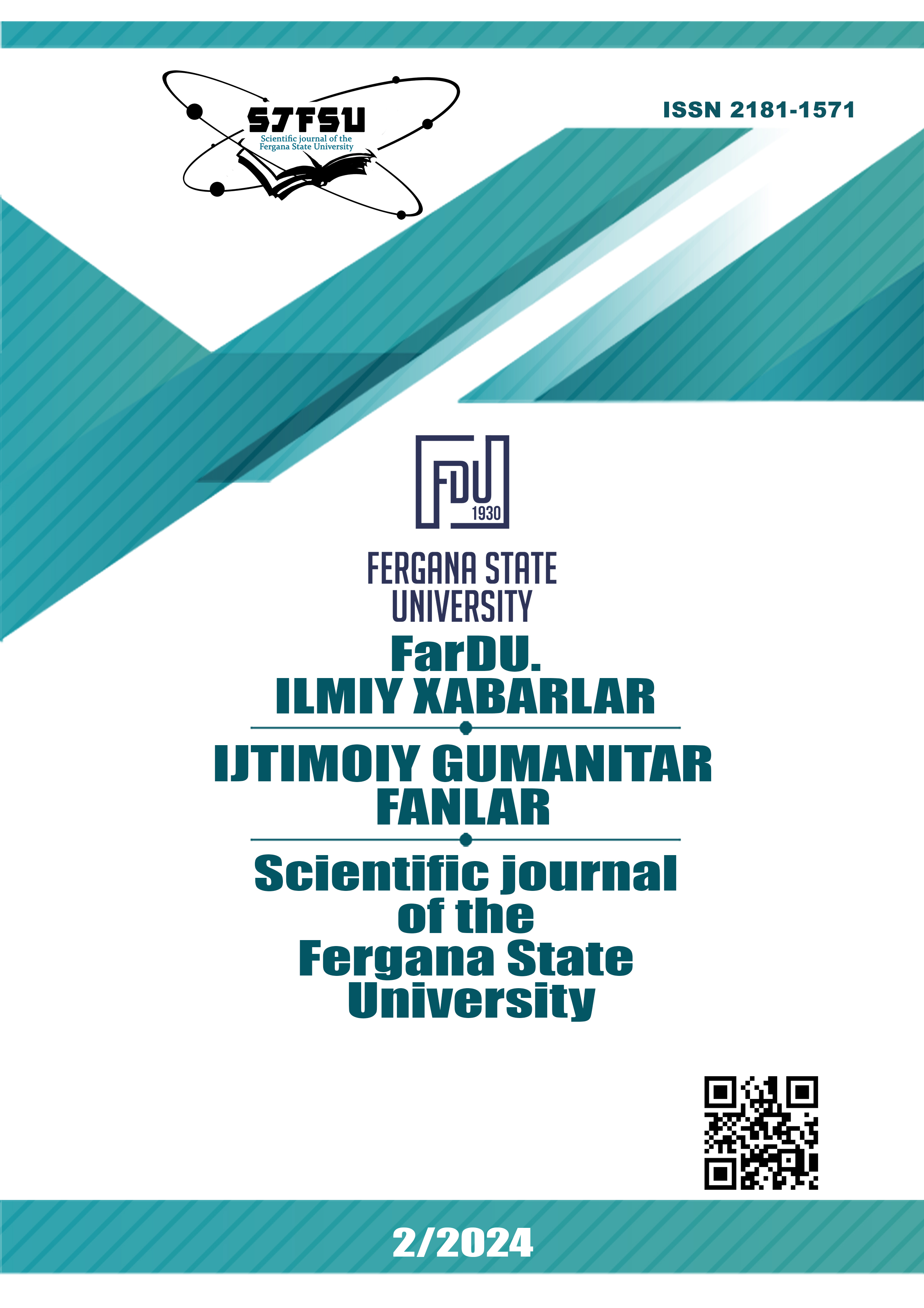STRUCTURE, FUNCTIONS AND IMPLEMENTATION FRAMEWORK OF THE WORLD TRADE ORGANIZATION
Keywords:
World Trade Organization, WTO Ministerial Conference, WTO Secretariat, WTO relationship with the UN, UNCTAD, IMF, IBRD, FAO, WIPO, OECD, WTO Committees.Abstract
In the article, the authors describe the structure, functions and scope of the World Trade Organization (WTO), as
well as emphasize the role and importance of the organization's Secretariat in conducting the trade policy of this
organization. It was emphasized that the specialists of the Republic of Uzbekistan should learn from the experience of
experts working in the Secretariat of the organization
References
World Trade Organization. (2017b). Marrakesh Agreement Establishing the World Trade Organization. Retrieved from https://www.wto.org/english/docs_e/legal_e/04-wto_e.htm.
Torgovaya politika i znachenie vstupleniya v VTO dlya razvitiya Rossii i stran SNG. Rukovodstvo. // Pod red. Devida G. Tarra. – M.: Izd-vo «Ves mir», 2006. – S. 269.; Lissovolik, B. & Lissovolik, L. (2007). Russia and the WTO: The gravity of outsider status. IMF Working Paper, WP/04/159.
Kuznesova I.P. Vsemirnaya torgovaya organizatsiya: funksii, problemы, perspektivы // EKO, 2006. - № 6. – S. 4; O’Neil, J. (2016). Accession to the World Trade Organization: Sector Level Impacts on the Extensive and Intensive Margins of Trade. Retrieved from: http://blogs.colgate.edu/economics/files/2016/06/ONeil-061516.compressed.pdf.
Torgovaya politika i znachenie vstupleniya v VTO dlya razvitiya Rossii i stran SNG. Rukovodstvo. // Pod red. Devida G. Tarra. – M.: Izd-vo «Ves mir», 2006. – S. 270; Lissovolik, B. & Lissovolik, L. (2007). Russia and the WTO: The gravity of outsider status. IMF Working Paper, WP/04/159.Ijtimoiy gumanitar fanlar
Rubinshteyn T.B. VTO: prakticheskiy aspekt. – Moskva: Gelios ARV, 2005. – S. 24; Bagwell, K. & Staiger, R.W. (2002). Economic Theory and the Interpretation of GATT/WTO. The American Economist, 46.2, 3-19. http://journals.sagepub.com/doi/pdf/10.1177/056943450204600201.
Chang, P.L. & Lee M.J. (2011). The WTO Trade Effect. Journal of International Economics, 85.1, 53-71. http://www.sciencedirect.com/science/article/pii/S0022199611000717
Dutt, P., Mihov, I. & Van Zandt, T. (2013). The effect of the WTO on the extensive and the intensive margins of trade. Journal of International Economics, 91.2, 204-219.http://www.sciencedirect.com/science/article/pii/S0022199613000901.
Rose, A.K. (2007). Do We Really Know That the WTO Increases Trade? Reply. The American Economic Review, 97.5, 2019-2025. http://www.jstor.org/stable/30034598.; Sauvé, P. (2016). Life beyond local content: Exploring alternative measures of industry support in the context of WTO accession. Indian Institute of Foreign Trade, Journal of International Trade, 1, 1-29. https://boris.unibe.ch/94430/.
World Trade Organization. (2017f). WTO and the Sustainable Development Goals. Retrieved from https://www.wto.org/english/thewto_e/coher_e/sdgs_e/sdgs_e.htm.
Subramanian, A. & Wei, S.J. (2007). The WTO promotes trade, strongly but unevenly. Journal of International Economics, 72, 151-175.
Evenett, S.J. & Primo Braga, C.A. (2005). WTO Accession: Lessons from Experience. International Trade Department, World Bank Group. June 6, 2005. Retrieved from:http://siteresources.worldbank.org/INTRANETTRADE/Resources/Pubs/TradeNote22.pdf.
Downloads
Published
Issue
Section
License
Copyright (c) 2024 Scientific journal of the Fergana State University

This work is licensed under a Creative Commons Attribution-NonCommercial-NoDerivatives 4.0 International License.
How to Cite
Most read articles by the same author(s)
- , PEDAGOGICAL BASIS OF WESTERN AND EASTERN PHILOSOPHY: ANALYSIS AND DISCUSSION , Scientific journal of the Fergana State University: No. 2 (2023): Scientific journal of the Fergana State University (Exact and natural sciences)
- , ON DAMMED LAKES AND THEIR GENESIS , Scientific journal of the Fergana State University: No. 4 (2023): Scientific journal of the Fergana State University (Exact and natural sciences)
- , , GEOGRAPHICAL DISTRIBUTION OF DAM LAKES IN CENTRAL ASIA AND ISSUES OF ASSESSING THE DEGREE OF THEIR HAZARD , Scientific journal of the Fergana State University: No. 3 (2024): FarDU.Ilmiy xabarlar jurnali (Aniq va tabiiy fanlar)
- , INTERCULTURAL DIALOGUE BASED ON THE MUTUAL INFLUENCE OF EASTERN AND WESTERN PHILOSOPHIES OF EDUCATION , Scientific journal of the Fergana State University: No. 3 (2023): Scientific journal of the Fergana State University (Social humanities sciences)
- , , DAMMED LAKES IN UZBEKISTAN AND ADJACENT MOUNTAINOUS COUNTRIES, THEIR STUDY AND AGGRAVATION OF RELATED PROBLEMS , Scientific journal of the Fergana State University: No. 3 (2024): FarDU.Ilmiy xabarlar jurnali (Aniq va tabiiy fanlar)
- Fayzullo Saidkulov, Ravshan Mahkamov, Arzigul Kurbanbayeva, Shuhrat Samandarov, Mohira Nurmanova, STUDY OF CALLOID CHEMICAL PROPERTIES OF NEW SURFACTANTS BASED ON PHENOL , Scientific journal of the Fergana State University: No. 1 (2023): Scientific journal of the Fergana State University (Exact and natural sciences)
- , INTERCULTURAL DIALOGUE BASED ON THE MUTUAL INFLUENCE OF EASTERN AND WESTERN PHILOSOPHIES OF EDUCATION , Scientific journal of the Fergana State University: No. 2 (2023): Scientific journal of the Fergana State University (Social humanities sciences)
- , PEDAGOGICAL FOUNDATIONS OF THE DEVELOPMENT OF STUDENTSʼ KNOWLEDGE BASED ON INTERDISCIPLINARY COOPERATION , Scientific journal of the Fergana State University: No. 6 (2023): FarDU ilmiy xabarlari jurnali (Ijtimoy gumanitar fanlar)
- , THE ROLE OF NATIONAL VALUES IN THE IMPLEMENTATION OF THE DEVELOPMENT STRATEGY OF NEW UZBEKISTAN , Scientific journal of the Fergana State University: No. 2 (2024): FarDU.Ilmiy xabarlar jurnali (Aniq va tabiiy fanlar)
- , GENETIC BASIS OF FLOOD RISK ASSESSMENT ON DAM LAKES , Scientific journal of the Fergana State University: No. 6- TOM (2023): SPECIAL ISSUE

